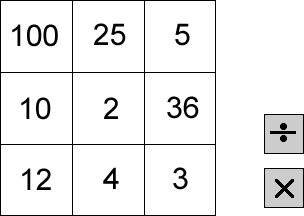Skip over navigation
Here's a game to play with an adult!

How do you play?
You'll need an adult to play with.
You'll also need a number line from 1-20, like the one above. You can print some off here.
The adult chooses two numbers in this grid and either multiplies or divides them.

They then mark the answer to the calculation on the number line. You then choose two numbers and either × or ÷ , and mark that number in a different colour on the number line.
If the answer is too big or too small to be marked on the number line, the player misses a go. The winner is the person to get four marks in a row with none of their opponent's marks in between.
What good ways do you have of winning the game?
Does it matter if you go first or second?
How are you deciding which number to aim for next?
Can you find a winning strategy?



Or search by topic
Number and algebra
Geometry and measure
Probability and statistics
Working mathematically
Advanced mathematics
For younger learners
Four Go for Two
Age 7 to 11
Challenge Level 





- Game
Here's a game to play with an adult!

How do you play?
You'll need an adult to play with.
You'll also need a number line from 1-20, like the one above. You can print some off here.
The adult chooses two numbers in this grid and either multiplies or divides them.

They then mark the answer to the calculation on the number line. You then choose two numbers and either × or ÷ , and mark that number in a different colour on the number line.
If the answer is too big or too small to be marked on the number line, the player misses a go. The winner is the person to get four marks in a row with none of their opponent's marks in between.
What good ways do you have of winning the game?
Does it matter if you go first or second?
How are you deciding which number to aim for next?
Can you find a winning strategy?
Notes for adults
This game gives children the opportunity to estimate answers to calculations in a motivating context and gives plenty of practice in multiplication and division. Playing strategically involves higher-order thinking and the need to think ahead.
Easier version: you could use a calculator, and/or adapt the grid and numberline.
Harder version: children can be encouraged to tweak the game and to try out their new version. For example, they might change the number line, the grid of numbers, the operations, the number of numbers needed to win...
There is a classroom version of this game here.
This game gives children the opportunity to estimate answers to calculations in a motivating context and gives plenty of practice in multiplication and division. Playing strategically involves higher-order thinking and the need to think ahead.
Easier version: you could use a calculator, and/or adapt the grid and numberline.
Harder version: children can be encouraged to tweak the game and to try out their new version. For example, they might change the number line, the grid of numbers, the operations, the number of numbers needed to win...
There is a classroom version of this game here.
You may also like
Exploring Wild & Wonderful Number Patterns
EWWNP means Exploring Wild and Wonderful Number Patterns Created by Yourself! Investigate what happens if we create number patterns using some simple rules.
Sending Cards
This challenge asks you to investigate the total number of cards that would be sent if four children send one to all three others. How many would be sent if there were five children? Six?
Dice and Spinner Numbers
If you had any number of ordinary dice, what are the possible ways of making their totals 6? What would the product of the dice be each time?

